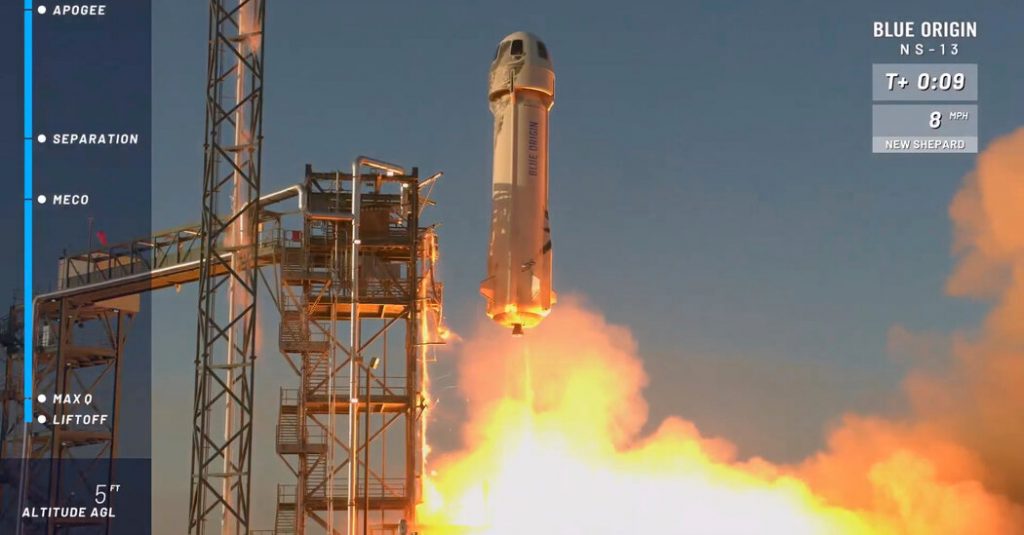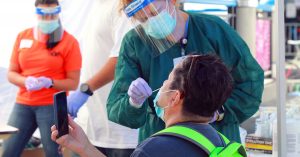Blue Origin’s New Shepard Rocket Launches a New Line of Business
8 min read
West Texas is not fairly like the moon. But it can provide as a useful stand-in.
On Tuesday, Blue Origin, the rocket firm started by Jeffrey P. Bezos, the main government of Amazon, launched — and landed — its modest New Shepard rocket and capsule for the 13th time as component of tests to verify basic safety prior to any passengers climb aboard.
One particular working day, this will be New Shepard’s main organization: flying perfectly-to-do men and women earlier mentioned the 62-mile altitude generally considered the commencing of outer space wherever they will encounter a number of minutes of weightlessness as the capsule arcs.
Blue Origin is not a new business — Mr. Bezos launched it in 2000 — but for most of its existence, it operated in magic formula with out generating considerably profits. 3 decades back, Mr. Bezos mentioned he was selling a billion bucks a 12 months in Amazon inventory to finance Blue Origin’s investigate and advancement. And he has declared wide ambitions for its organization, such as competing with Elon Musk’s SpaceX and other people in the orbital launch organization, constructing a moon lander for NASA astronauts and inevitably producing it attainable for thousands and thousands of men and women to are living and function in house.
But the cargo of Tuesday’s start from a check web site near Van Horn, Texas, exhibits that the organization is getting a far more modest company in the limited expression: turning the reusable New Shepard rocket and capsule into an productive, and worthwhile, system for testing new technologies and performing scientific experiments.
“It was wonderful,” claimed Erika Wagner, Blue Origin’s payload profits director, who was in West Texas. “We had been seeing throughout the valley and observing the rocket climb up.”
Tucked less than the collar at the best of the booster on Tuesday’s launch were prototypes of sensors that could aid NASA astronauts safely and securely attain the lunar surface in a several many years. It is aspect of NASA’s Tipping Level method, which seeks to thrust modern technologies.
“Although not similar to a lunar lander, it is consultant in that entire-flight profile of approaching at a significant amount of velocity, and then throttling up an motor and performing a propulsive landing,” stated Stefan Bieniawski, who qualified prospects the Blue Origin side of the partnership with NASA. “In point, I think we’re actually at a little greater speeds than you would be approaching the moon. So it presents a small bit of a tension examination for some of these sensors.”
In contrast to NASA’s Apollo missions from 1969 to 1972, which visited distinct sections of the moon, the area agency’s existing Artemis method aims to make repeated visits near the lunar South Pole, wherever eternally shadowed craters have massive amounts of h2o ice. That will involve the potential to land shut to the very same place once more and once more.
To that end, NASA’s Langley Analysis Middle in Hampton, Va., has put in a long time establishing a method that bounces light off the floor to measure altitude and velocity of a descending spacecraft. This technological know-how, lidar, limited for light detection and ranging, is very similar to radar, but it must be equipped to deliver additional specific readings.
A second NASA method aboard Tuesday’s start was a take a look at of what is recognised as terrain relative navigation. Due to the fact there are no world positioning technique satellites orbiting the moon, a spacecraft has to count on its own smarts to ascertain its exact area. With this navigation system, a computer system compares illustrations or photos taken by a digicam with these saved onboard to ascertain its location.
The navigation method was turned on close to where the New Shepard booster reached its greatest point.
“The terrain navigation does not sit there and say, ‘Hey, I see a crater,’” Mr. Bieniawski reported. “It’s really hunting for contrasts in the scene. And in that way, it seriously doesn’t treatment regardless of whether it is on the moon or whether or not it is below on Earth.”
NASA paid out Blue Origin $1.5 million to mount its techniques on two flights of New Shepard. The second flight will incorporate one more lidar instrument that will create a three-dimensional map of the landscape under in purchase to discover and keep away from obstructions.
“Our objective is to ready a plug-and-perform precision landing system that NASA and field can use primarily based on a mission’s unique require,” Jim Bridenstine, the NASA administrator, claimed in a statement. “This integrated New Shepard examination will set us on that path, giving us unmatched intel about how the sensors, algorithms, and laptop function with each other.”
While there were being no people today in the New Shepard capsule on Tuesday, it was not empty. It carried NASA-financed science experiments as effectively as experimental cargo from personal businesses. New Shepard flights have already carried more than 100 payloads to the edge of place.
“We make cash on every single flight,” reported Bob Smith, the main executive of Blue Origin.
Dr. Wagner of Blue Origin claimed the scientists came to West Texas and were being enthusiastic to watch the launch and get started digging into the benefits the identical day. “They’re just bouncing up and down on their toes,” she mentioned.
The experiments on Tuesday’s flight incorporated the next iteration of a undertaking from Daniel Durda, a scientist at the Southwest Investigate Institute in Boulder, Colo. He referred to as it BORE II, the place BORE is a easy acronym for Box of Rocks Experiment.
“It’s basically a box of rocks,” Dr. Durda reported.
He is hoping to establish a program that can scoop up samples of dust from an asteroid. BORE II has crushed-up materials that is very similar in composition to specific carbon-rich asteroids.
During the weightless part of the flight, a tetrahedron-formed assortment machine, which Dr. Durda identified as a starfish, will unfold. Magnets mounted on the outer triangles — the arms of the starfish — should entice and maintain onto some of the crushed rocks. The gadget will then fold up once more, trapping the content.
“It’s form of a biomimicry thing if you consider about it,” Dr. Durda reported. “The way starfish feed is they kind of extrude their abdomen out and they pull them back again in and obtain what they’re carrying out. Which is kind of what we’re undertaking listed here.”
By testing the structure on a suborbital flight, Dr. Durda can discover out how substantially materials can be gathered and no matter if the apparatus operates without jamming.
“It’s the very very first phase in understanding how you might incorporate a sampler system like this into a spacecraft rendezvous mission in which you dump possibly dozens, numerous dozens of these small things throughout the floor of an asteroid,” he reported.
In the previous, experts seeking to research anything in a weightless atmosphere experienced other methods, but they all had drawbacks. They could fall an item off a tower, offering a several seconds of zero gravity or put an experiment on an airplane flying a route of an item in cost-free tumble, which delivered about 20 seconds of floating.
The luckiest experimenters could endeavor to be chosen amongst the couple jobs despatched to orbit, very first on the house shuttle and now to the Worldwide Space Station.
Autos identified as sounding rockets also headed to about the exact same altitude as New Shepard goes, but simply because they flew only after, they ended up considerably extra expensive. Tuesday’s New Shepard vehicle has introduced and landed seven moments.
With the new suborbital vehicles that fly regularly, the cost of receiving to space is much decreased for NASA as well as for educational and non-public experts.
The most well known solution, Mr. Smith explained, is what Blue Origin calls a solitary storage locker. “That starts off all over $100,000 for about 25 pounds and a thing the measurement of, let’s say, a microwave,” he mentioned. “But we also have numerous payloads that we use with pupils that go as reduced as $8,000.”
The suborbital investigate is a also indication that Blue Origin is generating a transform to turning into a lucrative business as it prepares to promote tickets to room travelers. It has nevertheless to announce a day or cost for people flights.
“It’s been a large amount of advancement in facilities personnel actually hoping to realize how do we run this a lot more like a enterprise as opposed to a study group,” Mr. Smith mentioned. “We’ve also absent from almost zero profits to now building hundreds of tens of millions of pounds of income per year.”
The corporation has levels of competition for the current market of sending experiments to room. Richard Branson’s Virgin Galactic, which also options to mail area visitors on suborbital jaunts, has been traveling experiments through its examination flights. One from College of Florida scientists, for illustration, tested imaging systems that capture the response of vegetation — what genes are turned on and off — to the stresses of spaceflight. (The similar scientists experienced an additional iteration of the experiment aboard Tuesday’s Blue Origin flight.)
Virgin Galactic’s house aircraft, known as SpaceShipTwo, is flown by two pilots, so it has carried folks to room, but it will not fly spending travellers until upcoming year.
“The complete check out of using these motor vehicles for analysis purposes has moved into the mainstream, and NASA has now been funding a whole lot of that variety of do the job.” said S. Alan Stern, associate vice president of the house science and engineering division at Southwest Study Institute who has been selected by NASA to accompany his study on a potential Virgin Galactic flight.
Dr. Stern will operate a lowlight camera, utilized previously on the room shuttle, to test how perfectly SpaceShipTwo can be employed for astronomical observations.
When Blue Origin and Virgin Galactic get started traveling folks, that will open an chance for experts to accompany their experiments. That could significantly simplify some study, mainly because researchers are a great deal far more flexible than devices.
“There are lots of matters you can do with individuals in the loop just since automation is high priced,” Dr. Stern reported. “And automation is failure vulnerable.”
Southwest Study Institute has procured its possess seats for its scientists on long term Virgin Galactic flights.
“We have to resort to automation in spaceflight, simply because it is been high priced and tricky to mail the experimenter,” Dr. Stern reported, “but in each other field, from volcanology to oceanography to polar scientific tests, we send out the experimenters into the discipline to do the experiment.”
A single of all those seats is to be crammed by Dr. Durda, who will accompany a long term Box of Rocks experiment.
By operating the experiment himself, he says he would get direct knowledge with how these components behave on an asteroid.
“I believe it is incredibly important for us to understand the conditions on their surfaces at a ‘gut instinct’ level the same way a industry geologist walking a Western desert landscape listed here on Earth does,” Dr. Durda stated.
“We’ve attained that degree of familiarity in just about every single other part of subject and laboratory science,” he stated. “It’s very long past time for place scientists to be ready to operate with that same enabling advantage.”



